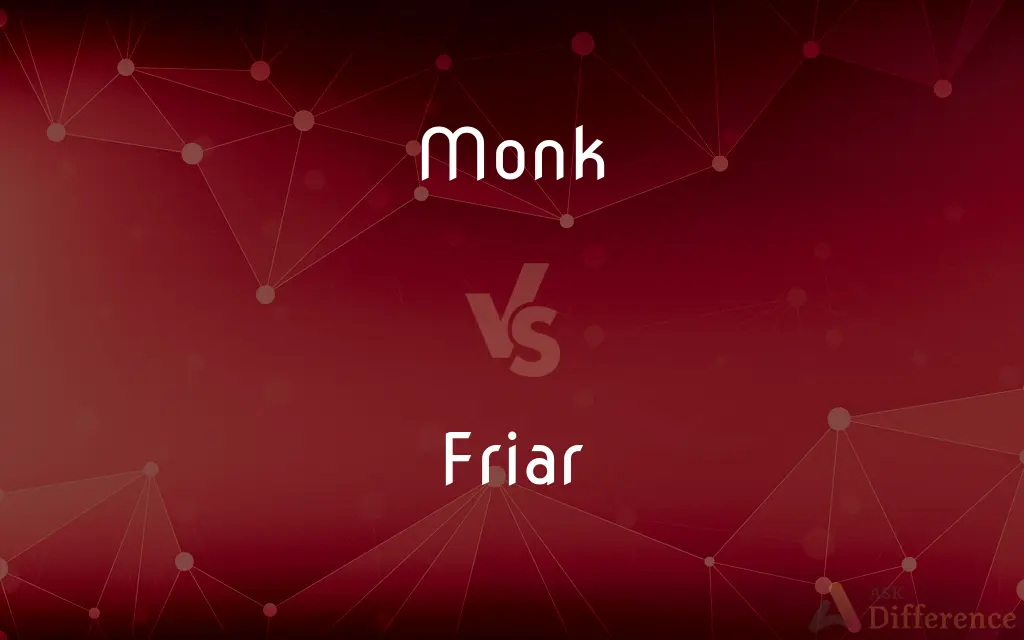Monk vs. Friar — What's the Difference?
By Maham Liaqat & Fiza Rafique — Updated on March 7, 2024
Monks often live in secluded monasteries focusing on prayer and work, while friars are part of religious orders that engage with the outside world.

Difference Between Monk and Friar
Table of Contents
ADVERTISEMENT
Key Differences
Monks are members of a religious community who live under vows of poverty, chastity, and obedience in a monastery, which is typically secluded from the wider community. Their lives are dedicated to serving God through prayer, meditation, and sometimes manual labor within the confines of their monastery. On the other hand, friars belong to mendicant orders and take similar vows but are distinct in their active engagement with society. They often work in communities, providing teaching, preaching, and other services to laypeople.
While monks seek a life removed from the outside world to focus on spiritual growth and self-sufficiency within their community, friars maintain a closer relationship with society. Friars' missions often lead them to travel and interact with people, reflecting their orders' emphasis on outreach and ministering to the needs of others. This fundamental difference in lifestyle and interaction with the world outside their religious community distinguishes friars from monks.
The concept of a monk originated in the East with the development of monasticism, where solitude and desert living were idealized for spiritual growth. In contrast, friar orders, such as the Franciscans and Dominicans, emerged in the Western Church during the Middle Ages, emphasizing poverty, mobility, and public ministry. This historical context underpins the different focuses and lifestyles of monks and friars.
Monasteries where monks reside are often self-sufficient, with members contributing to the community through various forms of work, including agriculture, writing, and craftsmanship. Friars, meanwhile, may live in friaries or convents within urban settings, from where they venture out to fulfill their vocations in education, healthcare, and pastoral care.
Despite these differences, both monks and friars live lives of devotion and service, guided by their vows and spiritual commitments. Their choice of a cloistered or active life reflects their order's charism and the manner in which they feel called to serve God and the community.
ADVERTISEMENT
Comparison Chart
Living Arrangement
In secluded monasteries
In communities, often within urban settings
Engagement with Society
Limited, focused on internal community
Active, with significant outside engagement
Lifestyle
Contemplative, often self-sufficient
Mendicant, focused on outreach and service
Origin
Eastern monasticism, emphasizing solitude
Western mendicant orders, emphasizing poverty and mobility
Primary Activities
Prayer, meditation, manual labor within monastery
Teaching, preaching, and serving laypeople
Compare with Definitions
Monk
Member of a Monastic Community.
As a monk, he vowed to live a life of poverty, chastity, and obedience.
Friar
Member of a Mendicant Order.
The friar traveled through towns, preaching and aiding the poor.
Monk
Religious Recluse.
The monk spent hours in silent prayer, secluded from the world.
Friar
Lives in a Friary or Convent.
The friary in the heart of the city served as a base for the friars' charitable works.
Monk
Lives in a Monastery.
The ancient monastery housed monks who dedicated their lives to spiritual pursuits.
Friar
Engages with Society.
Friars are known for their active engagement in community service and education.
Monk
Engages in Manual Labor.
The monk worked in the monastery's gardens as part of his daily routine.
Friar
Mendicant Lifestyle.
Adopting a mendicant lifestyle, the friar relied on alms for sustenance while serving the community.
Monk
Contemplative Lifestyle.
Monks often lead a contemplative lifestyle, focusing on meditation and prayer.
Friar
Vows of Poverty, Chastity, and Obedience.
Despite his active role in society, the friar adhered strictly to his vows.
Monk
A monk (, from Greek: μοναχός, monachos, "single, solitary" via Latin monachus) is a person who practices religious asceticism by monastic living, either alone or with any number of other monks. A monk may be a person who decides to dedicate his life to serving all other living beings, or to be an ascetic who voluntarily chooses to leave mainstream society and live his or her life in prayer and contemplation.
Friar
A friar is a brother and a member of one of the mendicant orders founded in the twelfth or thirteenth century; the term distinguishes the mendicants' itinerant apostolic character, exercised broadly under the jurisdiction of a superior general, from the older monastic orders' allegiance to a single monastery formalized by their vow of stability. The most significant orders of friars are the Dominicans, Franciscans, Augustinians and Carmelites.
Monk
A man who is a member of a brotherhood living in a monastery and devoted to a discipline prescribed by his order
A Carthusian monk.
A Buddhist monk.
Friar
A member of a usually mendicant Roman Catholic order.
Monk
A male member of a monastic order who has devoted his life for religious service.
Friar
A member of a mendicant Christian order such as the Augustinians, Carmelites (white friars), Franciscans (grey friars) or the Dominicans (black friars).
Monk
In earlier usage, an eremite or hermit devoted to solitude, as opposed to a cenobite, who lived communally.
Friar
A white or pale patch on a printed page caused by poor inking.
Monk
(slang) A male who leads an isolated life; a loner, a hermit.
Friar
An American fish, the silverside.
Monk
(slang) A judge.
Friar
A brother or member of any religious order, but especially of one of the four mendicant orders, viz: (a) Minors, Gray Friars, or Franciscans. (b) Augustines. (c) Dominicans or Black Friars. (d) White Friars or Carmelites. See these names in the Vocabulary.
Monk
(printing) A blotch or spot of ink on a printed page, caused by the ink not being properly distributed; distinguished from a friar, or white spot caused by a deficiency of ink.
Friar
A white or pale patch on a printed page.
Monk
A piece of tinder made of agaric, used in firing the powder hose or train of a mine.
Friar
An American fish; the silversides.
Monk
A South American monkey (Pithecia monachus); also applied to other species, as Cebus xanthosternos.
Friar
A male member of a religious order that originally relied soley on alms
Monk
The bullfinch, common bullfinch, European bullfinch, or Eurasian bullfinch (Pyrrhula pyrrhula).
Monk
The monkfish.
Monk
(historical) A fuse for firing mines.
Monk
(colloquial) A monkey.
Monk
To be a monk.
Monk
To act like a monk; especially to be contemplative.
Monk
To monkey or meddle; to behave in a manner that is not systematic.
Monk
To be intoxicated or confused.
Monk
To be attached in a way that sticks out.
Monk
A man who retires from the ordinary temporal concerns of the world, and devotes himself to religion; one of a religious community of men inhabiting a monastery, and bound by vows to a life of chastity, obedience, and poverty.
Monks in some respects agree with regulars, as in the substantial vows of religion; but in other respects monks and regulars differ; for that regulars, vows excepted, are not tied up to so strict a rule of life as monks are.
Monk
A blotch or spot of ink on a printed page, caused by the ink not being properly distributed. It is distinguished from a friar, or white spot caused by a deficiency of ink.
Monk
A piece of tinder made of agaric, used in firing the powder hose or train of a mine.
Monk
A South American monkey (Pithecia monachus); also applied to other species, as Cebus xanthocephalus.
Monk
A male religious living in a cloister and devoting himself to contemplation and prayer and work
Monk
United States jazz pianist who was one of the founders of the bebop style (1917-1982)
Common Curiosities
What distinguishes a monk from a friar?
The key distinction lies in their way of life; monks live a secluded, contemplative life in monasteries, while friars are part of mendicant orders that engage actively with the outside world.
Can monks and friars be found in all religions?
While the concepts of monks and friars are primarily associated with Christianity, particularly within the Roman Catholic Church, similar ascetic and mendicant traditions can be found in various religions.
Why do friars engage with society?
Friars engage with society as part of their religious calling to serve people directly through teaching, preaching, and providing various forms of aid, reflecting their orders' commitment to outreach and ministry.
Is it possible for a monk to become a friar, or vice versa?
While it is possible for someone to transition from monastic life to a mendicant order or vice versa, it involves a discernment process and acceptance by the new community, respecting the distinct vocations.
What is a monk?
A monk is a member of a religious community who lives under vows of poverty, chastity, and obedience, typically in a secluded monastery, dedicated to a life of prayer and work.
Do monks and friars take the same vows?
Both monks and friars typically take vows of poverty, chastity, and obedience, but their interpretation and the way they live out these vows can differ based on their distinct lifestyles and missions.
What roles do friars play in the community?
Friars serve in various roles, including educators, counselors, caregivers, and parish priests, actively participating in the spiritual and social well-being of the communities they serve.
Are all monks cloistered?
While many monks live cloistered lives within monasteries, some monastic orders may have missions or roles that involve interaction with the outside world, albeit to a lesser extent than friars.
How do monks contribute to their communities?
Monks contribute to their communities through prayer, work within the monastery, and sometimes by creating goods or offering services that support the monastery's self-sufficiency.
Do monks and friars live in poverty?
Both monks and friars take vows of poverty, living without personal possessions and sharing communal resources, though the specifics can vary by order and community.
What is the historical origin of monks and friars?
Monasticism has its roots in the early Christian desert hermits, while mendicant orders like the Franciscans and Dominicans emerged in the Middle Ages, emphasizing poverty and active ministry.
Can friars be involved in missionary work?
Yes, friars often engage in missionary work, both domestically and internationally, as part of their commitment to preaching and serving communities.
How do monasteries and friaries differ?
Monasteries are often more secluded, focusing on the monastic community's internal life, while friaries serve as bases for friars' active work in the surrounding community.
How do monks and friars support themselves?
Monks often support themselves through work within the monastery and donations, while friars rely on alms, donations, and sometimes support from their ministry work.
Can women be monks or friars?
Women can join monastic orders and are typically known as nuns or sisters; some mendicant orders also have female branches, but they are usually referred to differently.
Share Your Discovery

Previous Comparison
Translation vs. Remeasurement
Next Comparison
Jeans vs. JeggingsAuthor Spotlight
Written by
Maham LiaqatCo-written by
Fiza RafiqueFiza Rafique is a skilled content writer at AskDifference.com, where she meticulously refines and enhances written pieces. Drawing from her vast editorial expertise, Fiza ensures clarity, accuracy, and precision in every article. Passionate about language, she continually seeks to elevate the quality of content for readers worldwide.














































